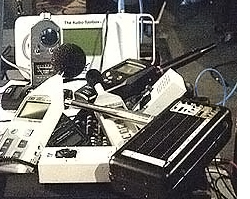
Whereas other electroacoustic measurement tools remain very subjective in how we interpret the data they provide, a reasonably accurate SLM provides an irrefutable means to objectively verify how loud the sound is (or is not).
SLM measurements may also be used to verify exactly how much the sound level has been changed (as noted in the section on relative versus absolute measurement).
Anyone involved in live sound system work is aware that there is an ongoing and increasing problem with the issue of volume levels produced in public performance, and specifically, in pop music reinforcement.
It’s wise for anyone involved in this field to become familiar with the actual measured numbers, not to mention the need to continually monitor what we are doing. Issues of personal health and legal liability are an ongoing and increasing concern.
Measurement of unintended noise levels and/or the effectiveness of acoustic treatment are additional exercises that most live sound folks eventually will become involved in.
How We Use Them
For basic every day sound system level measurement, using an SLM is fairly straightforward.
The standard SLM employs a free field microphone and is intended to be held at arm’s length and tipped up slightly towards the sound source.
As you move away from the source and into the reverberant or diffuse field, or when measuring in a multiple source sound field such as on stage, the angle of incidence of the microphone becomes much less of a concern.
When measuring noise levels at installation sites, some care should be taken. If measuring the noise level of a rack room, for example, be sure that the SLM is positioned away from walls, floors and other large boundaries.
Signal-to-noise levels are seldom an issue for loudspeaker system measurement because we can simply turn the system up, more than far enough above the noise floor.
But when measuring the noise from a loudspeaker system (hum, hiss and/or the fan noise that may exist in self-powered systems), or from a mixing console and its power supply, etc., or from other common noises such as HVAC systems, vacuum cleaners, power tools, etc., the unintended noise must be at least 10 dB-SPL lower than the noise being measured.
When measuring and logging levels to help resolve a dispute, both A and C weighted measurements should be provided, as should the distance from the source and any other detailed notes.
Also don’t forget that a non-annotated measurement (“00.0 dB-SPL”) will be interpreted to be flat (unweighted).
General Measurement Guidelines
When conducting sound pressure level measurements there are a few basic rules that apply:
• Keep the SLM at arm’s length, aimed in the direction of the sound source(s) and positioned away from room boundaries. By the way, the mixing surface on a large (40-plus channel) mixing console will effect SPL measurement when the SLM is laid down on the mixing surface or angled against the meter bridge.
• For almost all sound system measurements, use the A-weighting filter and Slow response setting.
• Be sure that you’re measuring within the range that you have selected. SLMs with multiple range positions and those with analog displays, in particular, may provide incorrect readings when the SPL is over/under the selected range.
• Prior to making SPL measurements, ensure that the SLM has been turned on for a few minutes and has reached room temperature.
• Wind and air-blowers will effect SPL measurements.
• Be aware of where you are taking your measurements. For example: if you measure from within the area where the bass energy from the sound system has combined (aka “power alley”) or within a standing wave null, the readings will be non-representative of the SPLs for the majority of the audience.
Tom Young is principle consultant for Electroacoustic Design Services in Connecticut, and he has designed hundreds of systems for churches and similar spaces. Tom’s also the moderator of the Church Sound Community Forum here on ProSoundWeb.
More articles by Tom Young on PSW:
Time Is On Your Side (If You Want It To Be) With Sound System Alignment
Microphone Techniques For Drums In Contemporary Worship Environments
The Aux-Fed Subwoofer Technique Explained
